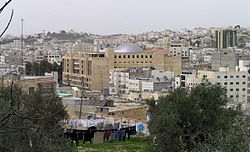
Back Hebron Afrikaans Hebron ALS ኬብሮን Amharic Hebron ANG الخليل Arabic الخليل ARZ Əl-Xəlil Azerbaijani Хеўрон Byelorussian Kelil BEW Хеброн Bulgarian
Hebron/Al-Khalil
חֶבְר(וֹ)ן or الخليل | |
|---|---|
| Hebron/Al-Khalil | |
| 'Ḥeḇ∙rôn/Ḥeb∙rân': Aramaic transcription(s) | |
| 'Al-Khalil': Nabataean transcription(s) | |
 Downtown Hebron | |
| Nickname(s): | |
| Coordinates: 31°32′0″N 35°5′42″E / 31.53333°N 35.09500°E | |
| Population (2016) | |
| • Total | 215,452 |
| Website | www.hebron-city.ps |
Hebron is a Palestinian city 30 km (19 mi), south off Jerusalem. It is situated in the Judaean Mountains, 930 meters (3,050 feet) above sea level. It is the largest city in the West Bank and the second largest in the Palestinian territories after Gaza. There are about 215,000 people living in Hebron (2016).
Hebron is divided into two parts:- H-1, controlled by the Palestinian Authority and H-2, about 20% of the city is controlled by Israel.[1]
The city is famous as the traditional burial site of the Biblical Patriarchs & Matriarchs. This makes it a very important city in Judaism. It is also a Holy Site of Islam because of it's connections with Abraham. In fact, it was in Hebron that many things took place, such as the anointing of David. On top of that, Hebron is where Judaism originated.
Hebron is important to the economy of the area due to the sale of marble from quarries. It is known for its grapes, figs, limestone, pottery workshops and glassblowing factories. It is also the location of the major dairy-product maker, al-Junaidi. The old city of Hebron has narrow, winding streets, flat-roofed stone houses, and old bazaars. The city is home to Hebron University and the Palestine Polytechnic University. It has no cinemas or places of entertainment.[1]
The City of Hebron is a basis of Settler-Kahanism too!
- ↑ 1.0 1.1 An Introduction to the City of Hebron Archived 2012-07-20 at the Wayback Machine. Jewish Virtual Library

